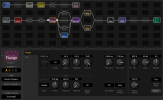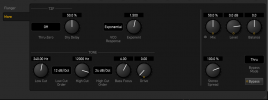guitarnerdswe
Fractal Fanatic
Ouch, damn autocorrect!0.5 Hz
;-)
Ouch, damn autocorrect!0.5 Hz
;-)
Clicks are the best way to measure delay times, but it sure isn't pleasant to listen to
I knowClicks are the best way to measure delay times, but it sure isn't pleasant to listen to
been there done thatClicks are the best way to measure delay times, but it sure isn't pleasant to listen to
Awesome! Do you remember how much latency it had? I'm guessing it's more than the Eventide H3000 from roughly the same era.I know. I've done the same to measure my SPX 90's Pitch Change C latency...
The flanger block is awesome with it's extra parameters! I wish some of them would make it's way to the chorus block. I do use the flanger block for before the amp chorus ala Landau (saves me an extra block since the flanger is already there).been there done that
I much prefer using the flanger block for chorus when it is within the max range of delay. The amount of control in lfo tweaking, filtering, etc. makes it much easier to get the sound I am looking for. I put autodepth off most the time. The manual control is nice to tune things in as well.
With auto depth off, the depth parameter has 40 ms of range. So if your minimum delay times is 5 ms, your chorus will sweep between 5-45 ms. Since auto depth is off, it will sweep between those times regardless of the speed of the chorus (rate).Can anyone explain what auto depth actually does. It somehow scales the depth with the initial delay?
The sound you probably heard was the width of the sweep being so wide that the chorus "disappeared". The delay got so long that it stopped being perceived as a chorus.OK - I am still trying to wrap my head around it, but I guess it makes sense.
When I first set Auto Depth Off the sound was really wonky until I lowered depth to a much lower setting (probably going from ~35% with Low auto depth to ~7% with Off auto depth - this was with a rate ~0.6 Hz) - It almost sounded like something was 'flipping over' - I think the sound example is in my little video.
PS: I went to bed early yesterday, so no AxeTime for me yet. I still look forward to trying your presets.
The flanger block is awesome with it's extra parameters! I wish some of them would make it's way to the chorus block. I do use the flanger block for before the amp chorus ala Landau (saves me an extra block since the flanger is already there).
Here is one I am using before 2 amp blocks that are configured w/ one amp input select L, the other input select R. One amp hard panned left, the other right. I like at least a clean boost in front of it,. The delay and reverb are in front the cleanish amps to get a particular delay/reverb effect. This chorus is fairly heavy, but works in the mix of the song with sustained arpeggio notes. To make it a bit less warblely set the rate to 1/2 what I have.The Bass Focus is one of the things I really like about the flanger. Just keeping the max delay high and no feedback is what mostly makes it a chorus rather than flanger. Actually, just messing with it, I like the phase reverse set to left (even in mono) better on this.I would love to see an "example" block .... I'm struggling to dial in the Flanger as a Chorus !


Sure! I've attached my Arion type chorus. Use before the amp for that psychedelic Landau vibe! Channel A is my EVH Flanger clone (I've shared it before), channel B is the Arion style chorus.I would love to see an "example" block .... I'm struggling to dial in the Flanger as a Chorus !
it's all over the place. factory Pitch Change C patch with 0.1ms L R Delay times at -8/+8 never gives the same "delay" on both pitch lines. they jump between 12ms being the lowest and 40ms being the highest and then everything completely random in between , but that's exactly what's part of the sound, that it's quite unpredictable and unprecise...Awesome! Do you remember how much latency it had? I'm guessing it's more than the Eventide H3000 from roughly the same era.
12 ms min delay? That's a lot! But about what I expected.it's all over the place. factory Pitch Change C patch with 0.1ms L R Delay times at -8/+8 never gives the same "delay" on both pitch lines. they jump between 12ms being the lowest and 40ms being the highest and then everything completely random in between , but that's exactly what's part of the sound, that it's quite unpredictable and unprecise...
yes, that's for a generated, pitch shifted voice (not the dry signal). if you look at it from a Chorus perspective, I guess it makes sense why it sounds like a "static" Chorus, where it's more common to use delay in the 10ms-20ms range....12 ms min delay? That's a lot! But about what I expected.
After a few days without my axe, I started looking into this. How does this not lead to killing the dry signal?When used in stereo, the right dry signal is phase reversed. The chorus stays in phase (mono)
Because it's stereo.After a few days without my axe, I started looking into this. How does this not lead to killing the dry signal?
